
Competitor analysis can keep your ecommerce brand one step ahead. Ecommerce is highly competitive, and our merchants are always asking for benchmarks and best practices. So why not take a leaf from your competitors’ playbook?
In this article, we’ll take a look at 13 awesome tools for competitor research you can use to research ecommerce brands. These are the same tools we use to research our case studies. You can draw inspiration from what the top brands are doing, or keep an eye on rivals and see if there’s a marketing tactic you missed.
Best of all, you can get this information without spending a single dollar: many of these tools have paid plans, but we kept to publicly accessible tools or those that just require email signup.
To illustrate this, let’s use an example. Let’s say I was trying to grow my athleisure brand, and I was inspired by Alo Yoga’s marketing success. I would start by with an overview of Alo Yoga’s marketing channels.
Click to jump to the sections below:
...
My first step is to understand Alo Yoga’s customer acquisition channels. I can do this by taking a look at the primary channels for web traffic and looking at what apps they use in their marketing stack.
Similarweb gives me a sense of the major web traffic channels for aloyoga.com:
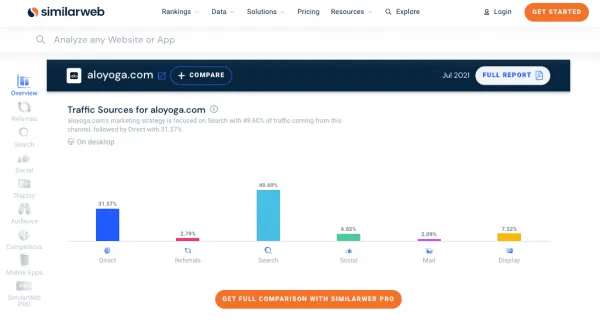
The breakdown of traffic shows that Alo Yoga sees a majority of traffic from the Search channel. It’s also interesting that Display ads drive more traffic than Social. (We can’t really quantify the Direct traffic.)
Scrolling down a little, we can see a breakdown of search traffic between paid and organic keywords:

Paid keywords make up almost half of the search traffic to Alo Yoga.com, and we can see two interesting details. One of the top paid keywords is Lululemon - so we know Alo Yoga considers them a big competitor. It also looks like Alo Yoga’s biker shorts are a popular item, and many customers are searching for them.
Similarweb also offers competitor analysis across social platforms, but it’s important to note that it only provides an estimate. It looks like Facebook drives more traffic than Instagram, but Alo Yoga has 2.8 million followers on Instagram and higher engagement, compared to their Facebook page with just 280,000 likes. That’s why you can’t just rely on one tool - and we’ve got you covered with social competitor research tools in the Social section below.
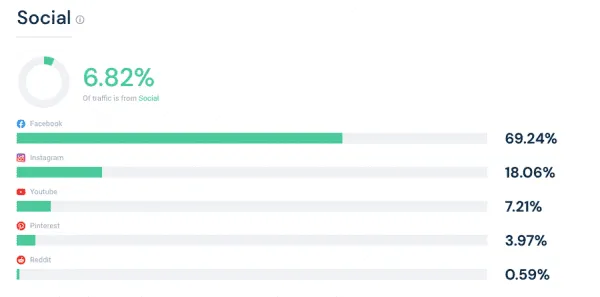
Delving into the Display Advertising section, I spotted an interesting pie chart. PepperJam, an affiliate network platform, drives almost half the traffic from display ads. We’ll see more of this later.
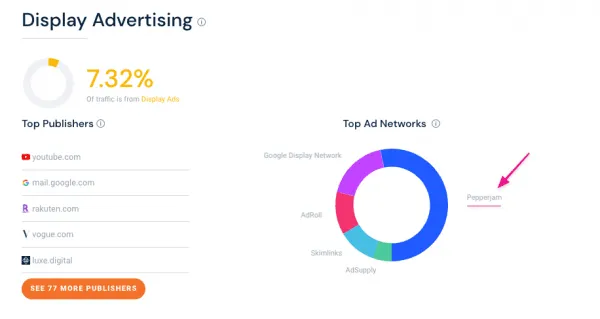
Now that I have an idea of how Alo Yoga gets web traffic, I’m going to take a look at what’s driving that traffic with BuzzSumo.
BuzzSumo surfaces content that’s popular on the web and social. I can search for ‘Alo Yoga’ and see what web content is getting shares and engagement on social platforms:
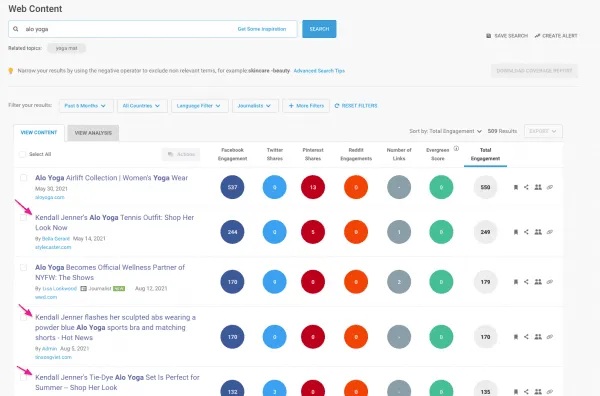
It’s clear that Alo Yoga’s collaboration with Kendall Jenner is creating a buzz, and gaining lots of attention in recent months. But that’s different from what’s trending on YouTube:
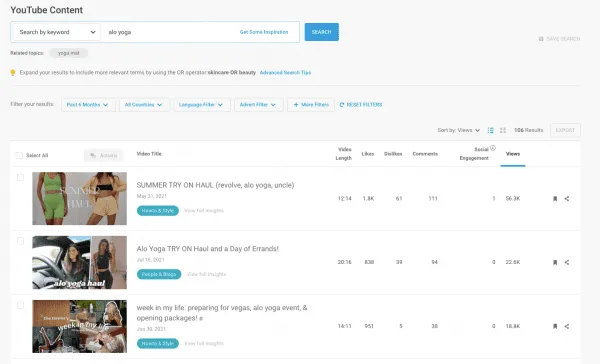
On YouTube, the most popular videos are try-on hauls and lifestyle vlog content with affiliate links through the PepperJam network. Aha! That gives me insight into how Alo Yoga runs its affiliate marketing program.
Now that I know what content Alo Yoga is promoting, I’m curious about how they’re doing it. That’s when I use Built With to check out their marketing tech stack.
BuiltWith profiles websites to give you insights on the technologies, analytics, and frameworks being used. The free lookup gives a glimpse at some of the Shopify apps in use:
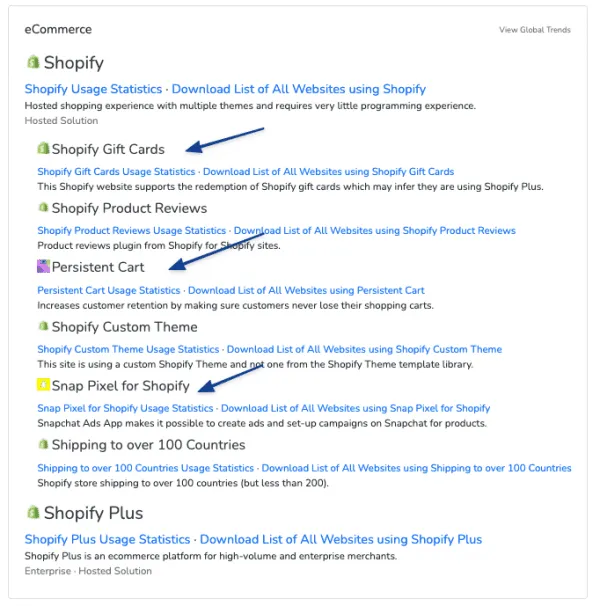
This peek gives us a few more pieces of insight:
We can also look at the advertising section to see which ad networks Alo Yoga are using:
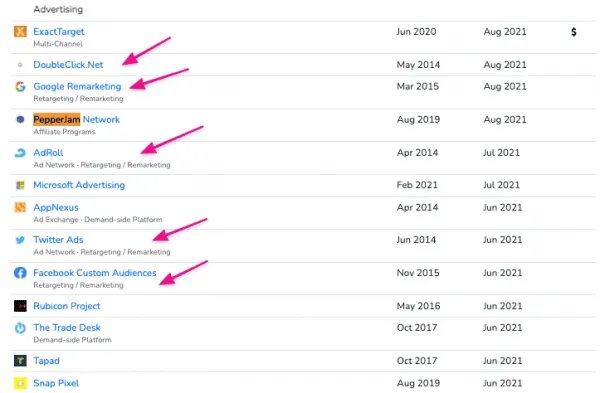
Now we know that Alo Yoga uses remarketing ads on Facebook, Google, Twitter, and AdRoll. We also see a second mention of the PepperJam affiliate network. What’s that about?
Let’s turn to our old friend Google:
It may seem obvious, but Google is a great tool for competitor research. If I want to know more about Alo Yoga’s affiliate program, simply searching for “alo yoga affiliate” shows me this:
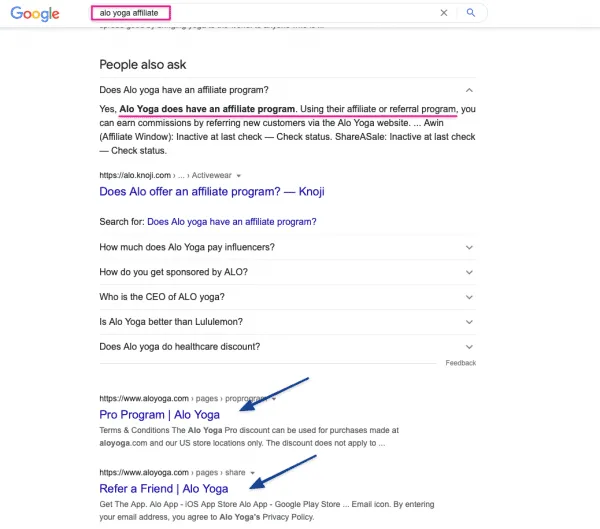
Now I know that Alo Yoga runs both an affiliate program as well as a referral program. I also see that Alo Yoga offers a Pro Program; a great way to get yoga instructors wearing Alo Yoga in front of yoga enthusiasts. That could be a marketing tactic I try for my athleisure brand.
There are also questions about how much Alo Yoga pays influencers, and how to get sponsored by Alo. That tells me that people are interested in being Alo Yoga affiliates, who I could recruit for my own affiliate program.
Google can also help with mapping the customer journey. When I search for Alo Yoga, I get hit with ads from Alo Yoga and competitors and see what’s trendy.
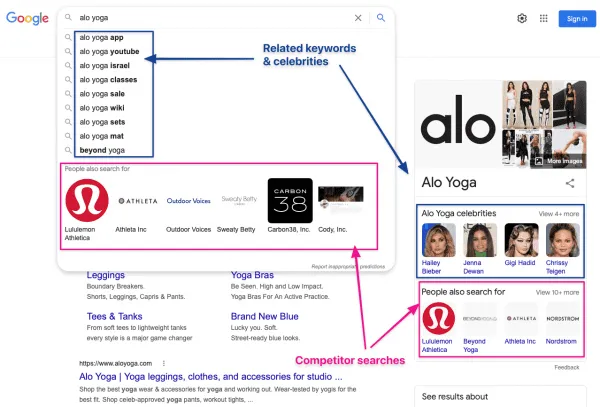
On closer inspection, Revolve and Mytheresa are ecommerce platforms that curate products from different brands and designers. Perhaps I should also consider selling my athleisure brand on these websites as well, to compete with Alo Yoga.
Now that we’ve gotten an overview of the marketing stack for Alo Yoga, let’s dive into the specifics: how Alo Yoga executes its marketing strategy on email, on social, and on search.
Email marketing is a big driver of ecommerce sales, which is why we recommend you A/B test your post-purchase emails.
One easy way for me to look at Alo Yoga’s emails is to subscribe to their newsletter, or even make a purchase directly - this can be valuable to understand the checkout process and the post-purchase retention efforts.
But what if I wanted to see an archive of past marketing emails & newsletters?
Milled.com bills itself as a search engine for newsletters, allowing brands to archive past emails for new customers to discover their email offers.
The Alo Yoga brand page offers a snapshot of the most recent emails:
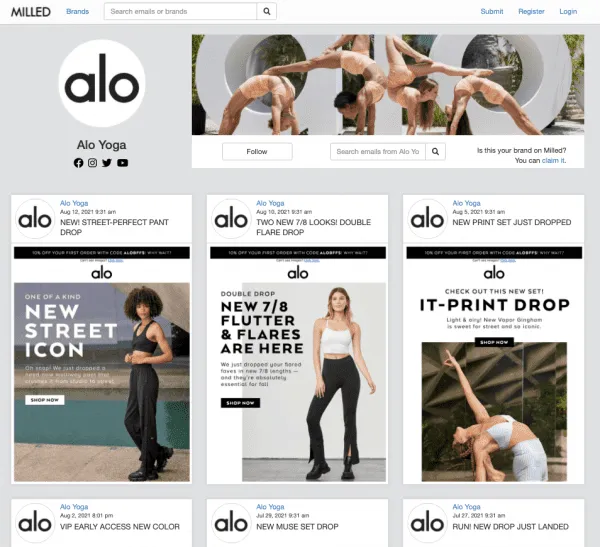
I can click through to individual emails. Alo Yoga lays out their emails vertically, making it easy for readers to scroll on mobile and see the different items on offer:

I can also search for a generic term like “yoga leggings” to see which other brands are sending them out.
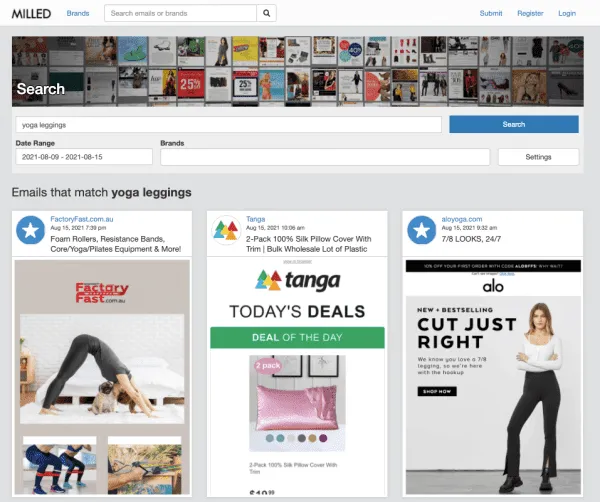
Mailcharts is another potential resource offering competitor email monitoring. With a free plan, you can create an account to look up the latest emails:
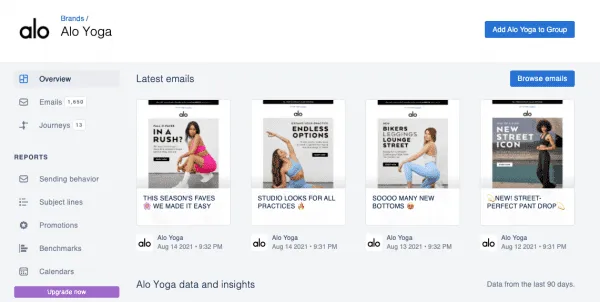
Milled and Mailcharts offer different emails
You’ll need a paid plan to look at email flows like onboarding and cart abandonment. But even on the free plan, you can get insights like how often emails are sent (7 times a week!) and how many emojis to use in subject lines (many, many):
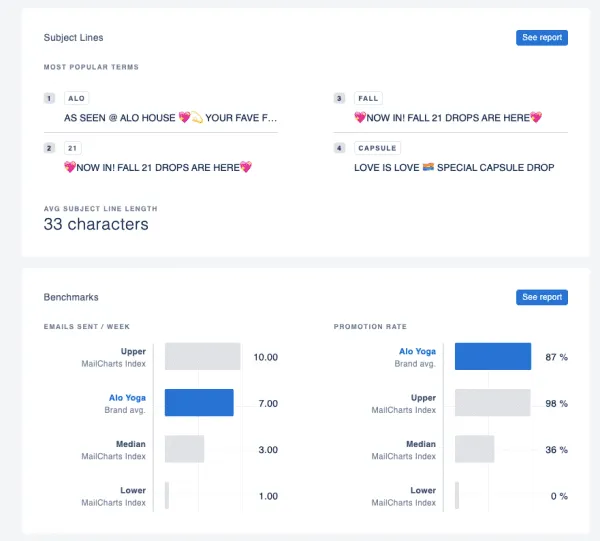
Now that we have a handle on Alo Yoga’s email strategy, let’s take a look at their social media.
Social media is where a majority of ecommerce content is posted and shared. It’s also a major source of engagement with fans, and a channel for ads as well.
To get a grasp of which channels Alo Yoga is using, I’d start with Social Blade.

SuperAds.ai is a cutting-edge AI-driven tool that helps marketers and creatives analyze ad performance across platforms like Meta, LinkedIn, and TikTok. Unlike traditional analytics tools that focus on budget optimization, SuperAds is designed to improve creative quality by providing actionable insights into what drives engagement and conversions.
With interactive dashboards, AI-powered categorization, and automated reporting, SuperAds enables marketing teams to quickly assess ad effectiveness based on key metrics such as click-through rates (CTR), impressions, cost-per-contact, and more. The AI Copilot further enhances decision-making by offering creative optimization suggestions based on historical data.
SuperAds.ai offers a free trial with core analytics, while advanced features such as AI-assisted insights and in-depth reporting are available in premium plans.
Social Blade tracks social platforms over time and reports on stats like posts, followers, and likes. For example, I can tell that Alo Yoga’s YouTube channel is slowing down, as total subscribers and weekly views are trending downwards:

Via SocialBlade
I can also get an overview of how often Alo Yoga posts on Instagram:

Via Social Blade
Alo Yoga’s Instagram engagement rate looks a little low at 0.20%. Is that normal for the number of followers it has?
According to Phlanx, it’s lower than expected.
Phlanx offers a suite of marketing tools for brands to work with influencers. One of their tools is a handy Instagram Engagement Calculator:
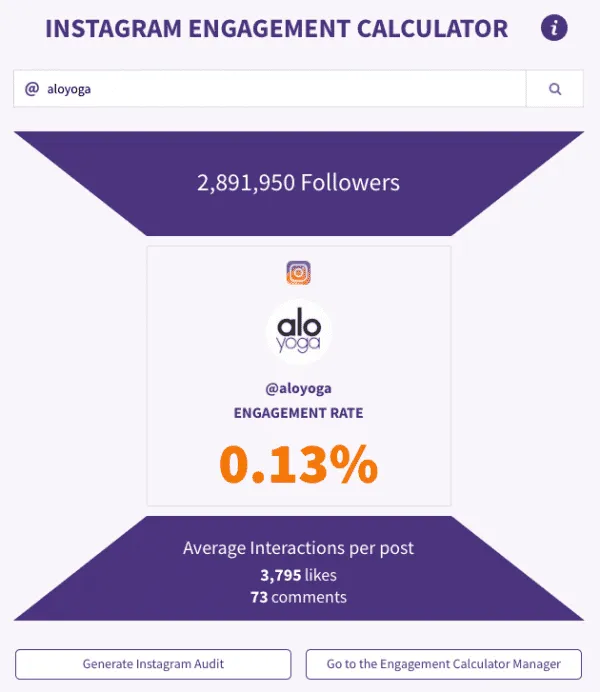
Right below the engagement rate calculator, Phlanx has left a handy little benchmark of average engagement rates. For their 2.8M followers, Alo Yoga has a lower than expected engagement rate.

A quick peek at @lululemon’s engagement rate (0.27%) suggests that Alo Yoga’s Instagram content may not be as engaging. There could be several reasons, including their many sub-brands (@alomen, @alo, @alomoves amongst others).
It’s time to use SparkToro to understand more about Alo Yoga’s followers.
SparkToro crawls both web and social posts to understand audiences. Here’s what the free tool says about people who follow Alo Yoga:
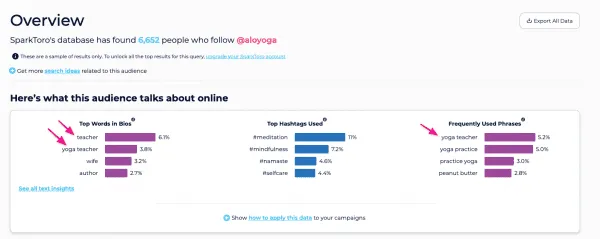
From this small sample, it looks like plenty of yoga teachers follow @aloyoga. Alo Yoga’s Pro Program looks like a masterstroke. I might also decide to investigate why ‘Peanut Butter’ is listed under frequently used phrases; there might be an opportunity for brand collaboration there.
I can also use SparkToro to see which other accounts this audience is following:
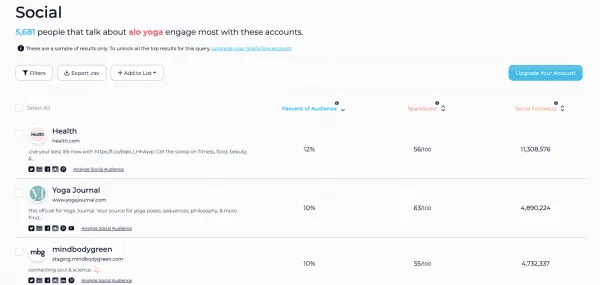
My athleisure brand will be looking to surface content on these pages to compete with Alo Yoga.
Now that we’ve covered the organic posts on social, it’s time to review the paid ads. And surprisingly, the best solution is to go directly to Facebook:
The Facebook ads library is a nifty tool you may not have known about. I can see every ad currently run by Alo Yoga’s Facebook and Instagram account, and filter by the geography and ad type:
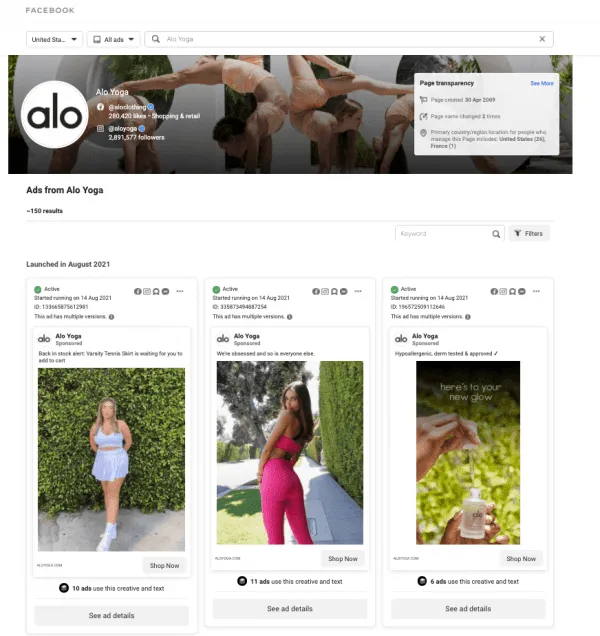
You can click on a particular ad to explore the different programmatic variations of each ad, and preview the copy and images:
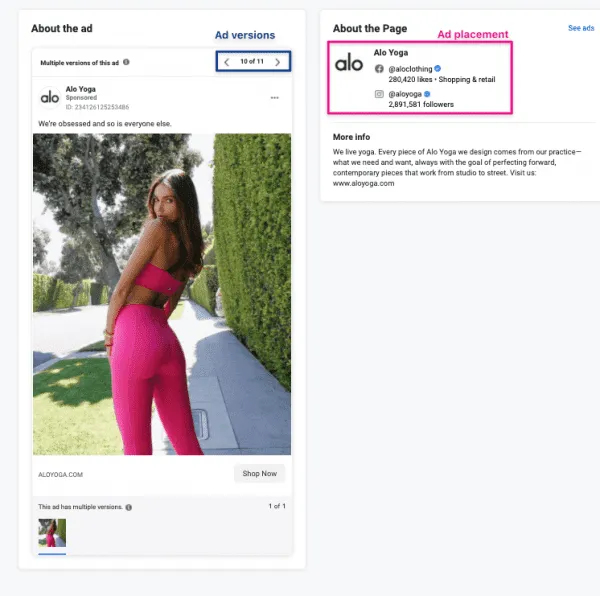
By far the most helpful feature is the tiny icons that show where the ads are being run. Here, Dream Legging’s ad is only run on Instagram, while Alo Yoga is running the same ad across Facebook, Instagram, Messenger, and mobile apps (via the Facebook Audience Network).
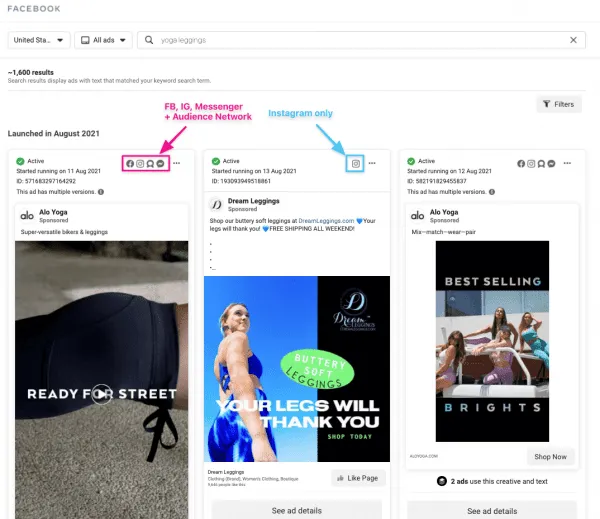
This is a search for a broader keyword like ‘Yoga Leggings’
Amongst other things, Moat.com bills itself as a search engine for display ads. You can browse the ad creatives for a particular brand, like Alo Yoga:
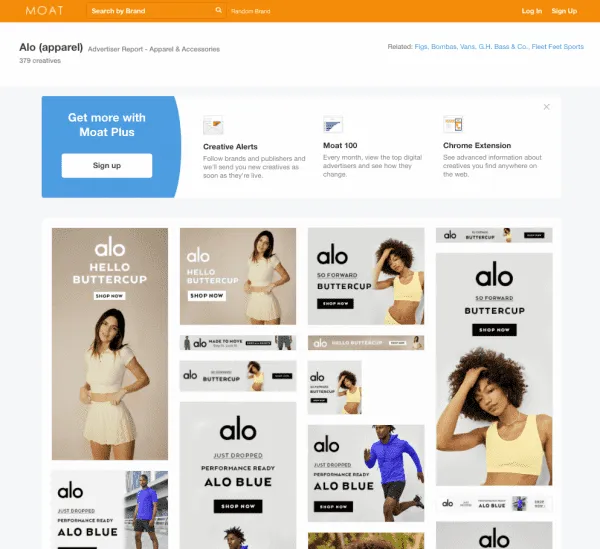
Via Moat.com
You can hover over each ad to take a look at the dimensions, devices, and active dates for each display ad, but the information seems incomplete. There also don’t seem to be any mobile ads archived here.

Looking at the creatives, Alo Yoga is launching new colors (Blue and Buttercup) for their fall collection. There’s also an advertising push behind their collaborations with Kendall Jenner and Frankies Bikinis. But are people doing Google searches about the collab?
It’s possible to use Google for keyword research. You can get a sense of the most common searches simply by looking at the auto-fill suggestions from Google:
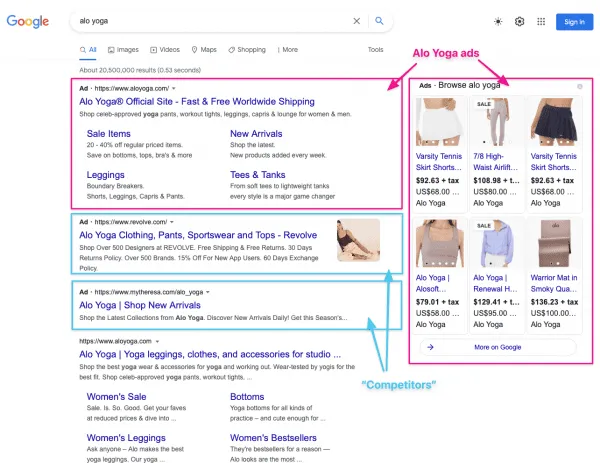
I also used a VPN to see what a customer from the United States sees.
But for a more specific overview, I use SpyFu from a choice of the best 60 SEO tools:
The free tool from SpyFu gives you an overview of the top paid and organic keywords for a particular domain.
Examining aloyoga.com, it seems that one of the most-searched-for keywords is ‘Kendall Jenner’. Alo Yoga’s collaborations are paying off: two of the pages getting the most search traffic are the collaborations with Kendall Jenner and Frankies Bikinis:
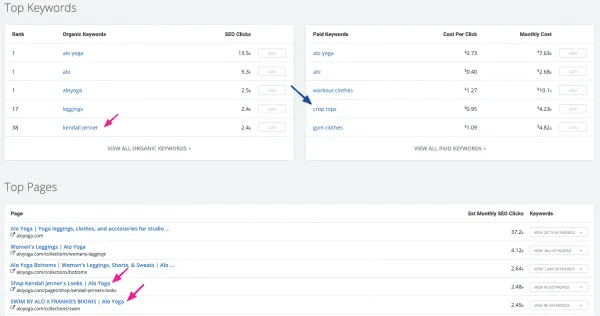
Via SpyFu
It’s also interesting that ‘crop tops’ is one of Alo Yoga’s top paid keywords. SpyFu’s PPC overview gives us a sample of what the search ad looks like:

Via SpyFu
My hypothetical athleisure brand will also need to sell crop tops to compete with Alo Yoga. But will it be worth bidding on “crop tops” as a keyword? Studying competitor PPC campaigns can help refine your own ad strategy.
UberSuggest is primarily a tool that suggests keyword ideas, but the free public tool does allow you to check on the top keywords by domain.
I pointed UberSuggest at aloyoga.com and filtered to see which organic keywords drive the most search traffic to the domain.

It turns out the reason Alo Yoga bids on ‘crop tops’ as a keyword is because they rank poorly for the organic keyword, and get fewer than 30 organic clicks a month. Meanwhile, their Frankies Bikinis collaboration is paying off, with about 1,000 estimated monthly visits.
It’s also worth noting that ‘Alo Yoga’ is the top keyword. Over 37,000 people every month search for ‘Alo Yoga’ to get to the website. As a competitor, I might try to bid on ‘Alo Yoga’ as a keyword to drive some of these searchers to my website instead.
(This is a tactic we saw Alo Yoga use on people searching for ‘Lululemon’, earlier in the Similarweb section.)
Using UberSuggest to check the keyword suggests that might be an expensive idea since the keyword has a high Cost Per Click (CPC) and the maximum paid difficulty. I suspect Alo Yoga’s other competitors may also be bidding on this keyword.
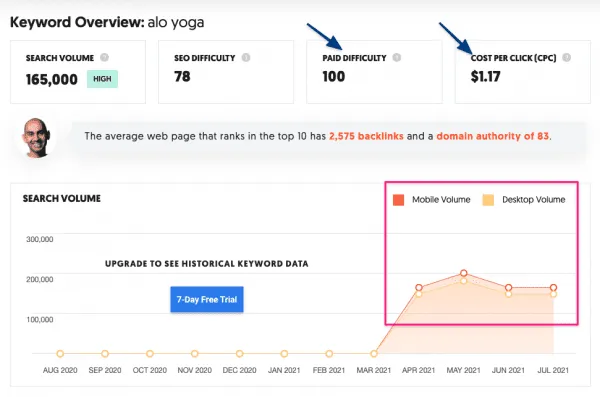
The final piece of competitor intelligence is that there are almost ten times as many desktop searches for 'Alo Yoga' compared to mobile:
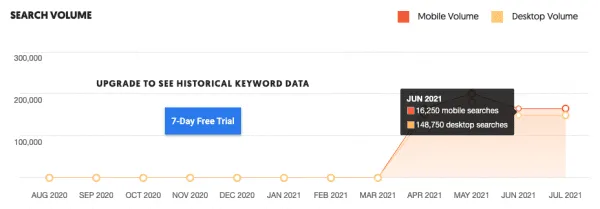
I might interpret that to focus on desktop placements for search ads. I could also investigate to see if shoppers do more browsing on desktop versus mobile.
In the course of writing this article, I’ve been followed across social media by ads for Alo Yoga’s dusty blue Plow Board Short from @alomen. Alo Yoga definitely has its remarketing strategy on lock. To take this one step further, I could buy those yoga shorts and pay attention to the customer retention tactics that follow.
These 13 tools allow you to zoom out and see your competitor’s efforts across multiple channels. And if you want to delve deeper into specifics, many of these tools come with paid versions and special reports.
The danger with competitor research is that you may be playing catch-up by reacting to their past strategies. You can take a proactive stance by exploring how you can diversify customer acquisition channels beyond ads, or join some ecommerce communities to meet like-minded individuals and exchange ideas.
Or, why not subscribe to our newsletter for more great ecommerce content?
Darren is a content/SEO writer and product marketer. He doubled search traffic for the blog and put ReferralCandy on the front page of the Shopify AppStore.
Grow your sales at a ridiculously
lower CAC.